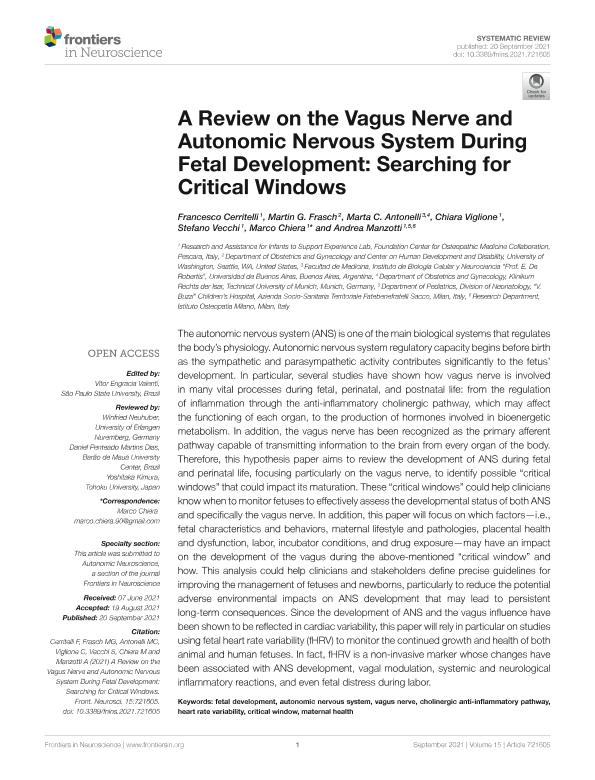Mostrar el registro sencillo del ítem
dc.contributor.author
Cerritelli, Francesco
dc.contributor.author
Frasch, Martin Gerbert

dc.contributor.author
Antonelli, Marta Cristina

dc.contributor.author
Viglione, Chiara
dc.contributor.author
Vecchi, Stefano
dc.contributor.author
Marco Chiera
dc.contributor.author
Andrea Manzotti
dc.date.available
2022-12-19T09:44:06Z
dc.date.issued
2021-09
dc.identifier.citation
Cerritelli, Francesco; Frasch, Martin Gerbert; Antonelli, Marta Cristina; Viglione, Chiara; Vecchi, Stefano; et al.; A Review on the Vagus Nerve and Autonomic Nervous System During Fetal Development: Searching for Critical Windows; Frontiers Media; Frontiers in Neuroscience; 15; 9-2021; 1-32
dc.identifier.issn
1662-453X
dc.identifier.uri
http://hdl.handle.net/11336/181671
dc.description.abstract
The autonomic nervous system (ANS) is one of the main biological systems that regulates the body's physiology. Autonomic nervous system regulatory capacity begins before birth as the sympathetic and parasympathetic activity contributes significantly to the fetus' development. In particular, several studies have shown how vagus nerve is involved in many vital processes during fetal, perinatal, and postnatal life: from the regulation of inflammation through the anti-inflammatory cholinergic pathway, which may affect the functioning of each organ, to the production of hormones involved in bioenergetic metabolism. In addition, the vagus nerve has been recognized as the primary afferent pathway capable of transmitting information to the brain from every organ of the body. Therefore, this hypothesis paper aims to review the development of ANS during fetal and perinatal life, focusing particularly on the vagus nerve, to identify possible “critical windows” that could impact its maturation. These “critical windows” could help clinicians know when to monitor fetuses to effectively assess the developmental status of both ANS and specifically the vagus nerve. In addition, this paper will focus on which factors—i.e., fetal characteristics and behaviors, maternal lifestyle and pathologies, placental health and dysfunction, labor, incubator conditions, and drug exposure—may have an impact on the development of the vagus during the above-mentioned “critical window” and how. This analysis could help clinicians and stakeholders define precise guidelines for improving the management of fetuses and newborns, particularly to reduce the potential adverse environmental impacts on ANS development that may lead to persistent long-term consequences. Since the development of ANS and the vagus influence have been shown to be reflected in cardiac variability, this paper will rely in particular on studies using fetal heart rate variability (fHRV) to monitor the continued growth and health of both animal and human fetuses. In fact, fHRV is a non-invasive marker whose changes have been associated with ANS development, vagal modulation, systemic and neurological inflammatory reactions, and even fetal distress during labor.
dc.format
application/pdf
dc.language.iso
eng
dc.publisher
Frontiers Media

dc.rights
info:eu-repo/semantics/openAccess
dc.rights.uri
https://creativecommons.org/licenses/by-nc-sa/2.5/ar/
dc.subject
AUTONOMIC NERVOUS SYSTEM
dc.subject
CHOLINERGIC ANTI-INFLAMMATORY PATHWAY
dc.subject
CRITICAL WINDOW
dc.subject
FETAL DEVELOPMENT
dc.subject
HEART RATE VARIABILITY
dc.subject
MATERNAL HEALTH
dc.subject
VAGUS NERVE
dc.subject.classification
Obstetricia y Ginecología

dc.subject.classification
Medicina Clínica

dc.subject.classification
CIENCIAS MÉDICAS Y DE LA SALUD

dc.title
A Review on the Vagus Nerve and Autonomic Nervous System During Fetal Development: Searching for Critical Windows
dc.type
info:eu-repo/semantics/article
dc.type
info:ar-repo/semantics/artículo
dc.type
info:eu-repo/semantics/publishedVersion
dc.date.updated
2022-09-21T18:41:48Z
dc.journal.volume
15
dc.journal.pagination
1-32
dc.journal.pais
Suiza

dc.description.fil
Fil: Cerritelli, Francesco. Foundation Center For Osteopathic Medicine Collaboration; Italia
dc.description.fil
Fil: Frasch, Martin Gerbert. University of Washington; Estados Unidos
dc.description.fil
Fil: Antonelli, Marta Cristina. Consejo Nacional de Investigaciones Científicas y Técnicas. Oficina de Coordinación Administrativa Houssay. Instituto de Biología Celular y Neurociencia "Prof. Eduardo de Robertis". Universidad de Buenos Aires. Facultad de Medicina. Instituto de Biología Celular y Neurociencia; Argentina
dc.description.fil
Fil: Viglione, Chiara. Foundation Center For Osteopathic Medicine Collaboration; Italia
dc.description.fil
Fil: Vecchi, Stefano. Foundation Center For Osteopathic Medicine Collaboration; Italia
dc.description.fil
Fil: Marco Chiera. Foundation Center For Osteopathic Medicine Collaboration; Italia
dc.description.fil
Fil: Andrea Manzotti. Foundation Center For Osteopathic Medicine Collaboration; Italia
dc.journal.title
Frontiers in Neuroscience
dc.relation.alternativeid
info:eu-repo/semantics/altIdentifier/doi/https://doi.org/10.3389/fnins.2021.721605
dc.relation.alternativeid
info:eu-repo/semantics/altIdentifier/url/https://www.frontiersin.org/articles/10.3389/fnins.2021.721605/full
Archivos asociados
